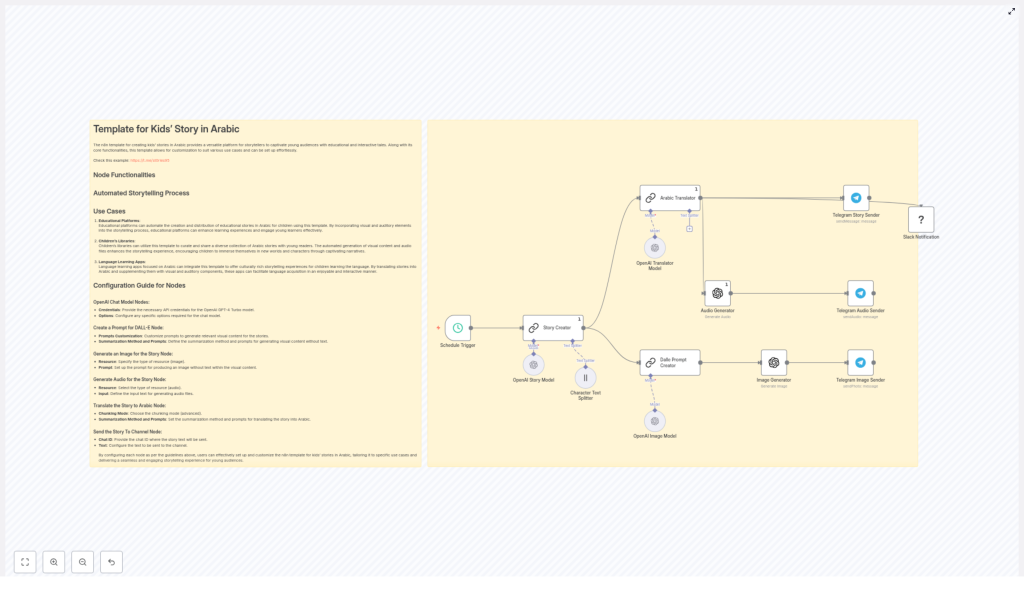Arabic Kids Story Workflow Template: Automate Charming Tales with n8n and OpenAI
Bring stories to life for young Arabic-speaking audiences by combining the power of n8n automation, OpenAI language models, DALL·E-style image generation, and Telegram distribution. This post explains the ready-made “Arabic Kids Story Workflow” template, how it works, how to customize it, and best practices for producing safe, engaging educational stories with audio and images.
Why use an automated storytelling workflow?
Automating the story creation and distribution process saves time and ensures consistent quality. With a single template you can:
- Generate original short tales tailored for kids using GPT-4-style models.
- Translate and adapt text into simple, child-friendly Arabic.
- Create non-text images (DALL·E prompts) that match story characters and scenes.
- Produce audio narration files for accessibility and multi-sensory learning.
- Deliver finished stories directly to Telegram channels or other channels.
Overview of the template
The workflow coordinates several nodes to produce a complete story package: text, images, and audio. Key components include:
1. Schedule Trigger
Start stories on a schedule (for example, every 12 hours). This makes it easy to publish new content automatically to a channel or feed.
2. Story Creator (Summarization/Generation Node)
Uses an OpenAI-powered summarization/chain node to craft a short, imaginative tale (~900 characters). Prompts are tuned to create child-friendly narratives that include a moral or learning point.
3. Arabic Translator
Translates and simplifies the generated story into easy-to-understand Arabic, using prompts that emphasize simple words, clear sentences, and a moral lesson suited for young readers.
4. Character Text Splitter
Splits long text into manageable chunks for downstream processing. This is useful for audio generation, translation, or multi-image prompts.
5. Dalle Prompt Creator + Image Generator
Summarizes characters and scenes into concise, non-text visual prompts for image generation. The Image Generator node then produces images while avoiding any text inside the visual content — ideal for illustrations that match the story while remaining universal.
6. Audio Generator
Turns the Arabic story text into audio narration files. These files can be uploaded to Telegram or stored for later use.
7. Telegram Senders (Text, Image, Audio)
Deliver the final story package (text, images, and audio) directly to a Telegram channel. This provides an instant distribution channel for subscribers and parents.
8. Optional Slack Notification
Send an internal notification to a Slack channel when a new story publishes, useful for editorial teams or collaborators.
Step-by-step setup
- Install n8n and import the template JSON into n8n’s editor.
- Provide OpenAI API credentials (GPT-4 Turbo and image endpoints) in node credentials.
- Set your Telegram bot credentials and the destination chat ID for your channel.
- Adjust the Schedule Trigger to your preferred publish frequency.
- Review and adapt the generation and translation prompts to match tone, age group, and cultural sensitivity.
- Test the flow end-to-end using the n8n manual trigger to confirm text, images, and audio deliver correctly.
Prompt and content tips
- Use explicit guidance in the story prompt to control length, tone, and moral focus (for example: “Make it gentle, playful, and include a lesson about sharing”).
- For the Arabic translator prompt, ask for “easy words”, short sentences, and an explicit moral sentence at the end.
- When creating image prompts, request “no text in the image” and provide short physical descriptions of characters (colors, clothing, animal vs human, mood).
- For audio, specify desired voice traits (gender-neutral, calm pace) if the TTS service supports it.
Customization ideas
Make the template fit your brand or learning goals:
- Change the story generator prompt to focus on cultural folktales, science concepts, or vocabulary-building themes.
- Integrate a CMS or Google Drive to store generated assets (images/audio) and archive stories.
- Localize to dialects or other languages by adding extra translation nodes or fine-tuned prompts.
- Add moderation checks (safety filters) before publishing to ensure appropriateness for kids.
Best practices for child-friendly content
- Keep language simple and sentences short for younger readers.
- Avoid complex or potentially sensitive topics; focus on universal lessons like kindness and curiosity.
- Include clear authorship and contact details in your channel to build trust with parents and educators.
- Regularly review output samples to detect and correct any undesirable AI artifacts.
Troubleshooting & tips
If images contain text or audio sounds unnatural:
- Refine the image prompt and re-run the Dalle Prompt Creator with explicit “no text” phrasing.
- For audio issues, test different TTS voices or chunk audio into smaller segments to improve pacing.
- If translations are too literal, instruct the translator node to “localize and simplify” rather than translate word-for-word.
Privacy and compliance
When distributing children’s content, handle user and channel data responsibly. Avoid collecting unnecessary PII, use secure API credentials, and follow relevant local laws for child-directed services.
Use cases
- Educational platforms delivering bite-sized moral tales for Arabic learners.
- Children’s libraries and cultural organizations creating illustrated stories on a schedule.
- Language learning apps that supplement lessons with audio stories and visuals.
Ready to try it?
This n8n template is a strong starting point for automated Arabic storytelling. It bundles generation, translation, illustration, audio, and distribution into one workflow that you can run on a schedule or trigger on demand.
Call to action: Import the template into your n8n instance, connect your OpenAI and Telegram credentials, and run a test story today. Want help customizing prompts or adding moderation? Contact us for professional setup and prompt engineering services to match the tone and audience you need.
Bonus: Keep a log of generated stories and review them periodically—this helps refine prompts and maintain a safe, delightful library for kids.

